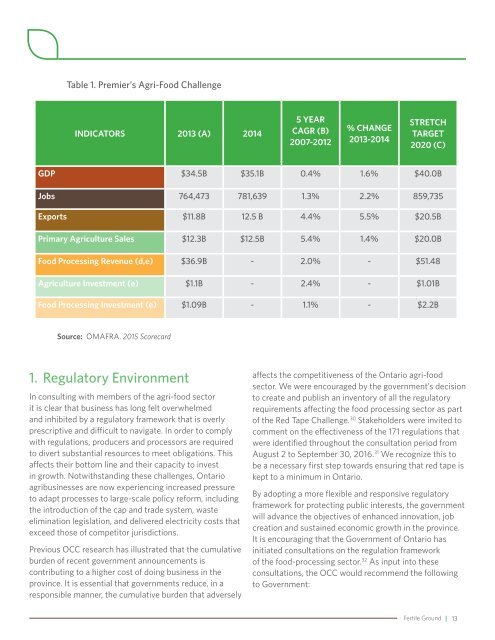FERTILE GROUND
2dJbGU4
2dJbGU4
Create successful ePaper yourself
Turn your PDF publications into a flip-book with our unique Google optimized e-Paper software.
Table 1. Premier’s Agri-Food Challenge<br />
INDICATORS 2013 (A) 2014<br />
5 YEAR<br />
CAGR (B)<br />
2007-2012<br />
% CHANGE<br />
2013-2014<br />
STRETCH<br />
TARGET<br />
2020 (C)<br />
GDP $34.5B $35.1B 0.4% 1.6% $40.0B<br />
Jobs 764,473 781,639 1.3% 2.2% 859,735<br />
Exports $11.8B 12.5 B 4.4% 5.5% $20.5B<br />
Primary Agriculture Sales $12.3B $12.5B 5.4% 1.4% $20.0B<br />
Food Processing Revenue (d,e) $36.9B - 2.0% - $51.48<br />
Agriculture Investment (e) $1.1B - 2.4% - $1.01B<br />
Food Processing Investment (e) $1.09B - 1.1% - $2.2B<br />
Source: OMAFRA. 2015 Scorecard<br />
1. Regulatory Environment<br />
In consulting with members of the agri-food sector<br />
it is clear that business has long felt overwhelmed<br />
and inhibited by a regulatory framework that is overly<br />
prescriptive and difficult to navigate. In order to comply<br />
with regulations, producers and processors are required<br />
to divert substantial resources to meet obligations. This<br />
affects their bottom line and their capacity to invest<br />
in growth. Notwithstanding these challenges, Ontario<br />
agribusinesses are now experiencing increased pressure<br />
to adapt processes to large-scale policy reform, including<br />
the introduction of the cap and trade system, waste<br />
elimination legislation, and delivered electricity costs that<br />
exceed those of competitor jurisdictions.<br />
Previous OCC research has illustrated that the cumulative<br />
burden of recent government announcements is<br />
contributing to a higher cost of doing business in the<br />
province. It is essential that governments reduce, in a<br />
responsible manner, the cumulative burden that adversely<br />
affects the competitiveness of the Ontario agri-food<br />
sector. We were encouraged by the government’s decision<br />
to create and publish an inventory of all the regulatory<br />
requirements affecting the food processing sector as part<br />
of the Red Tape Challenge. 30 Stakeholders were invited to<br />
comment on the effectiveness of the 171 regulations that<br />
were identified throughout the consultation period from<br />
August 2 to September 30, 2016. 31 We recognize this to<br />
be a necessary first step towards ensuring that red tape is<br />
kept to a minimum in Ontario.<br />
By adopting a more flexible and responsive regulatory<br />
framework for protecting public interests, the government<br />
will advance the objectives of enhanced innovation, job<br />
creation and sustained economic growth in the province.<br />
It is encouraging that the Government of Ontario has<br />
initiated consultations on the regulation framework<br />
of the food-processing sector. 32 As input into these<br />
consultations, the OCC would recommend the following<br />
to Government:<br />
Fertile Ground | 13


